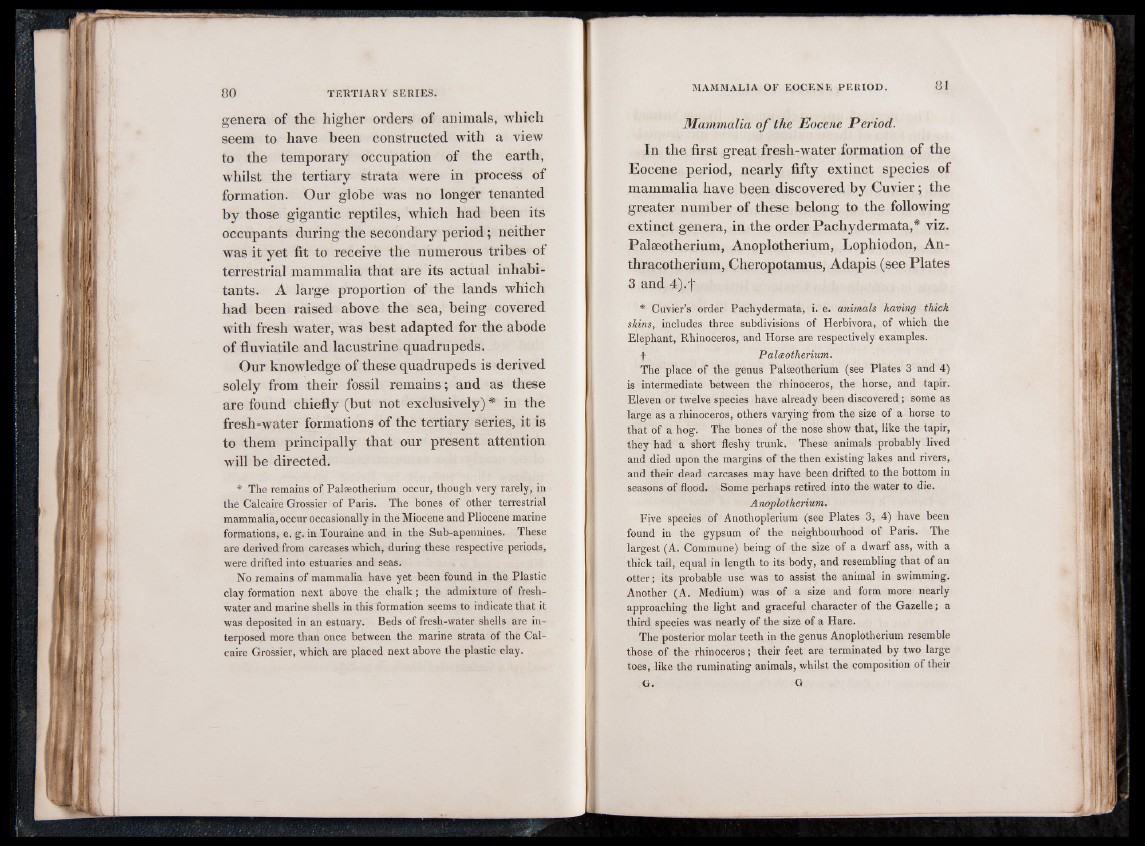
genera of the higher orders of animals, which
seem to have been constructed with a view
to the temporary occupation of the earth,
whilst the tertiary strata were in process of
formation. Our globe was no longer tenanted
by those gigantic reptiles, which had been its
occupants during the secondary period; neither
was it yet fit to receive the numerous tribes of
terrestrial mammalia that are its actual inhabitants.
A large proportion of the lands which
had been raised above the sea, being covered
with fresh water, was best adapted for the abode
of fluviatile and lacustrine quadrupeds.
Our knowledge of these quadrupeds is derived
solely from their fossil remains; and as these
are found chiefly (but not exclusively) * in the
fresh-water formations of the tertiary series, it is
to them principally that our present attention
will be directed.
* The remains of Palseotherium occur, though very rarely, in
the Calcaire Grossier of Paris. The bones of other terrestrial
mammalia, occur occasionally in the Miocene and Pliocene marine
formations, e. g. in Touraine and in the Sub-apennines. These
are derived from carcases which, during these respective periods,
were drifted into estuaries and seas.
No remains of mammalia have yet been found in the Plastic
clay formation next above the chalk; the admixture of freshwater
and marine shells in this formation seems to indicate that it
was deposited in an estuary. Beds of fresh-water shells are interposed
more than once between the marine strata of the Calcaire
Grossier, which are placed next above the plastic clay.
mammalia of eocene period. 81
Mammalia o f the Eocene Period.
In the first great fresh-water formation of the
Eocene period, nearly fifty extinct species of
mammalia have been discovered by Cuvier; the
greater number of these belong to the following
extinct genera, in the order Pachydermata,* viz.
Palseotherium, Anoplotherium, Lophiodon, An-
thracotherium, Cheropotamus, Adapis (see Plates
3 and 4).f
* Cuvier’s order Pachydermata, i. e. animals having thick
skins, includes three subdivisions of Herbivora, of which the
Elephant, Rhinoceros, and Horse are respectively examples.
f Palceotherium.
The place of the genus Palseotherium (see Plates 3 and 4)
is intermediate between the rhinoceros, the horse, and tapir.
Eleven or twelve species have already been discovered; some as
large as a rhinoceros, others varying from the size of a horse to
that of a hog. The bones of the nose show that, like the tapir,
they had a short fleshy trunk. These animals probably lived
and died upon the margins of the then existing lakes and rivers,
and their dead carcases may have been drifted to the bottom in
seasons of flood. Some perhaps retired into the water to die.
Anoplotherium.
Five species of Anothoplerium (see Plates 3, 4) have been
found in the gypsum of the neighbourhood of Paris. The
largest (A. Commune) being of the size of a dwarf ass, with a
thick tail, equal in length to its body, and resembling that of an
otter; its probable use was to assist the animal in swimming.
Another (A. Medium) was of a size and form more nearly
approaching the light and graceful character of the Gazelle; a
third species was nearly of the size of a Hare.
The posterior molar teeth in the genus Anoplotherium resemble
those of the rhinoceros; their feet are terminated by two large
toes, like the ruminating animals, whilst the composition of their
G. G